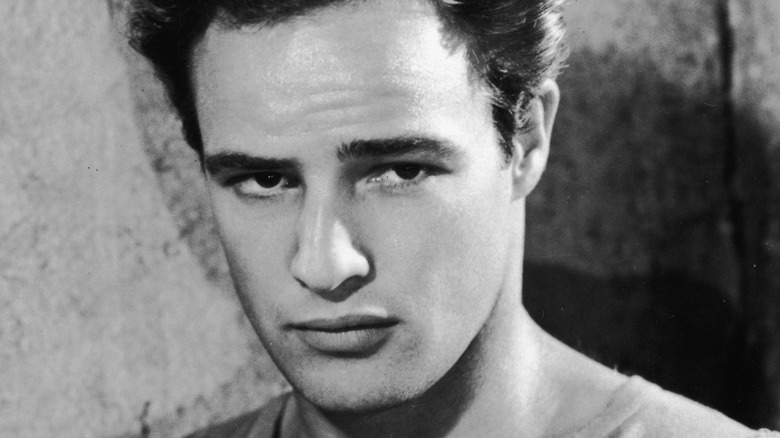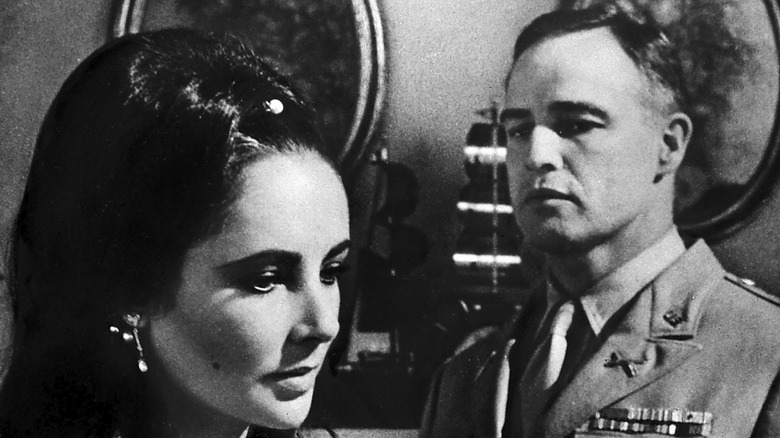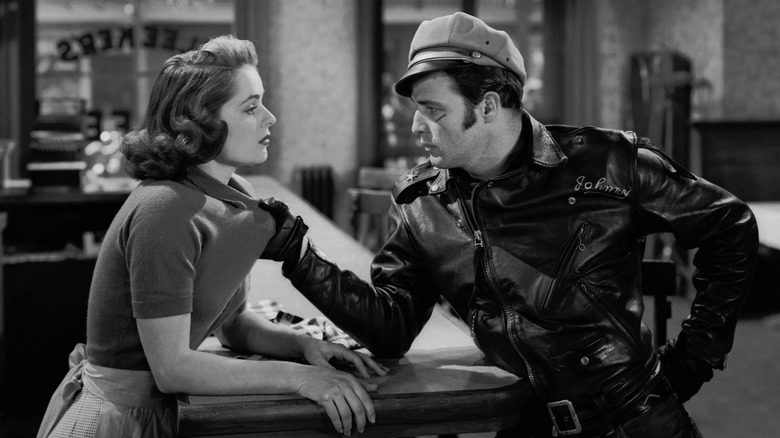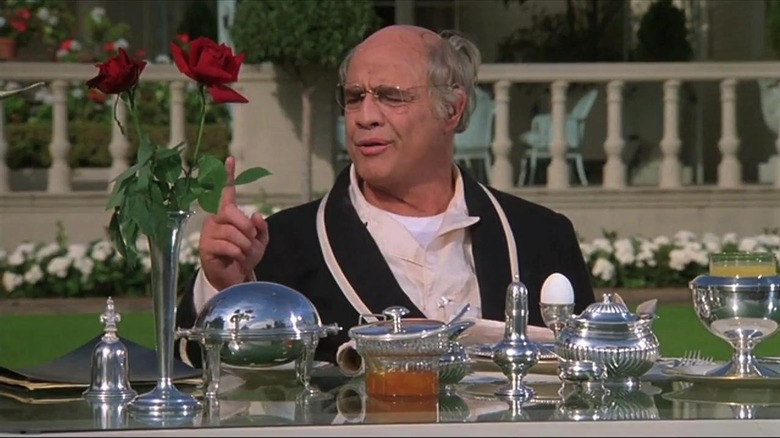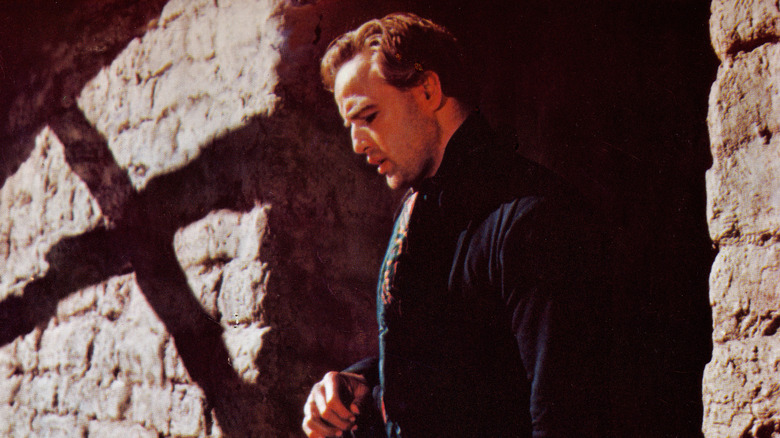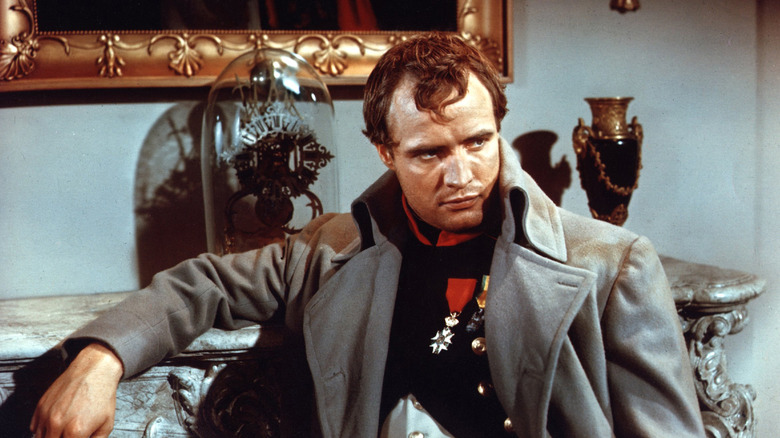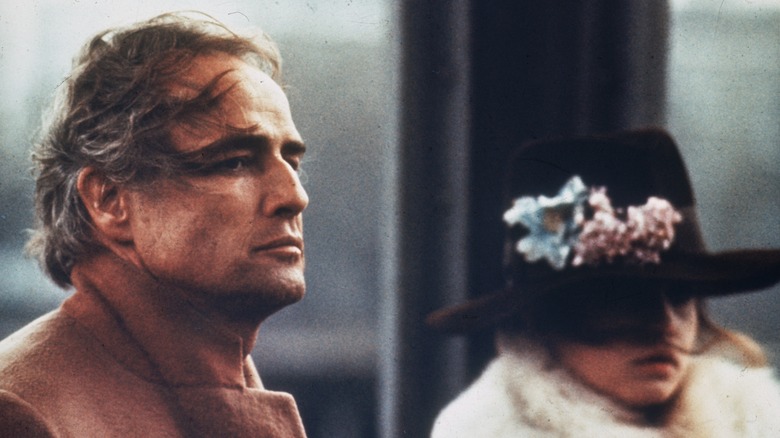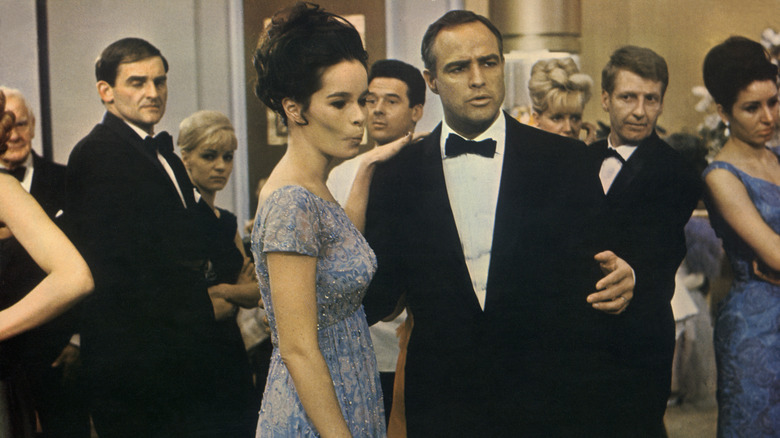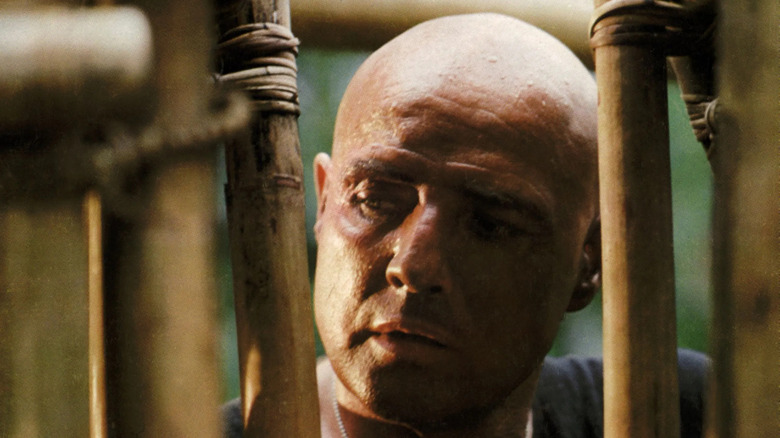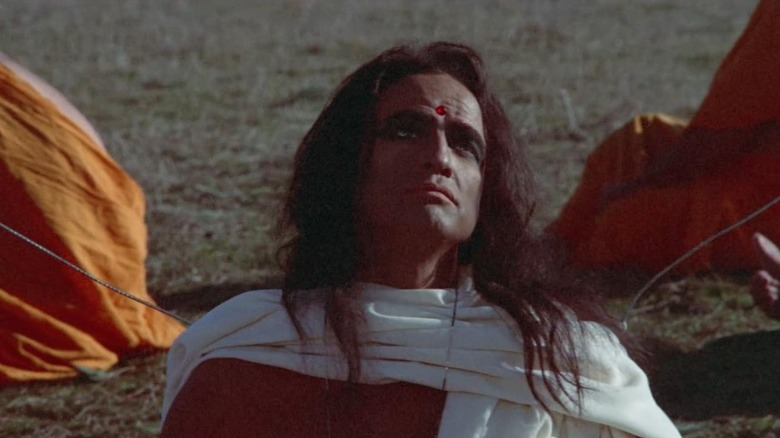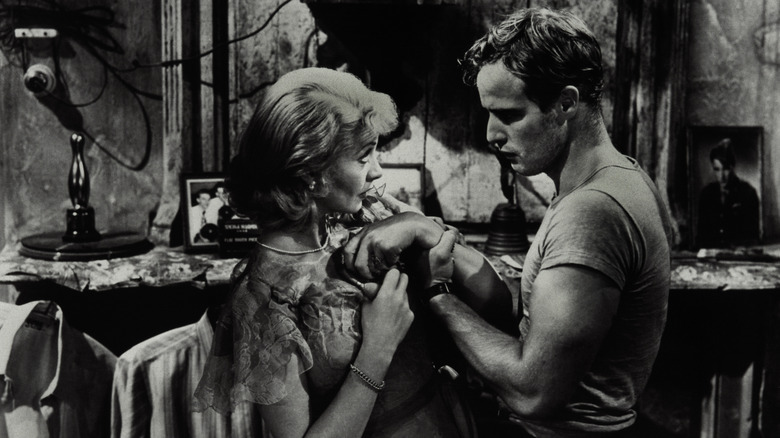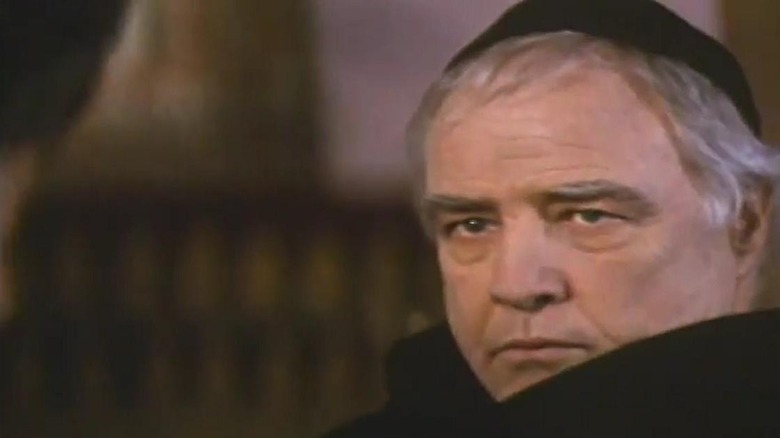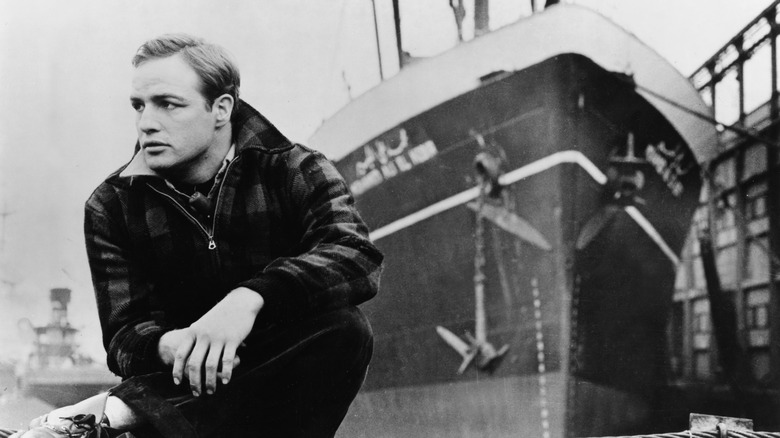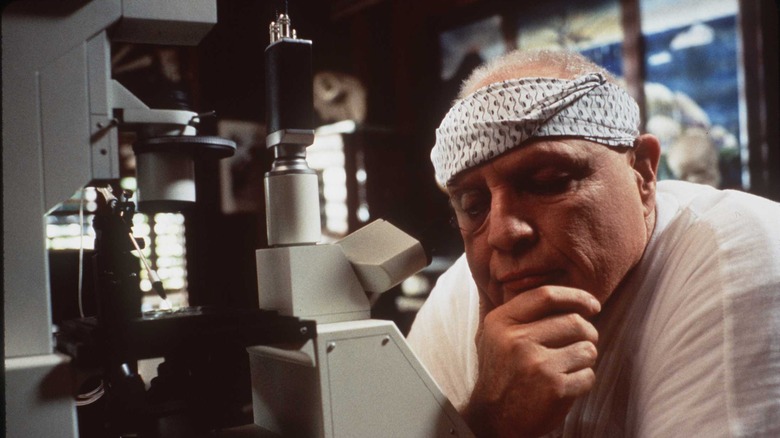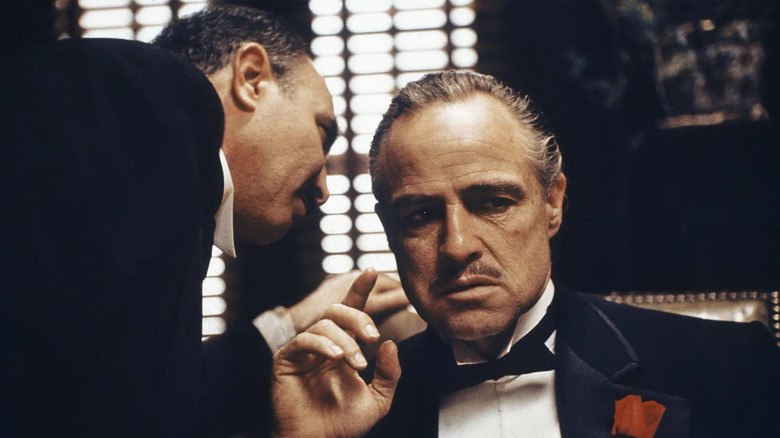Marlon Brando's 7 Best And 7 Worst Movies Ranked
Perhaps no other actor has had a greater impact on American film acting than Marlon Brando, who, as Roger Ebert wrote in his obituary, "was the most influential actor in the history of the movies, and one of the most exasperating. He was instrumental in the success of some of the greatest films of all time, and cheerfully appeared in some of the worst."
Born in 1924, Brando studied acting under the tutelage of Stella Adler, who taught the Stanislavski system. He employed this naturalistic approach, later coined the Method, first in the 1947 Broadway production of "A Streetcar Named Desire," and later in the 1951 screen adaptation. As Ebert puts it, "Look at old movies on TV, and you will sense a difference in the acting before and after 1947." Brando earned eight Oscar nominations, winning Best Actor prizes for "On the Waterfront" and "The Godfather."
Brando's offscreen behavior became the stuff of legends as well, from his political activism (he famously refused his Oscar for "The Godfather" in protest of Hollywood's depiction of Native Americans, sending activist Sacheen Littlefeather to refuse to award on his behalf) to his notorious interview with Larry King, which ended with him kissing the bewildered host on the mouth.
Through it all, he left behind some great movies, as well as some stinkers. Let's take a look back at Marlon Brando's seven best and seven worst films, ranked.
Worst: Reflections in a Golden Eye (1967)
One man's turkey is another man's camp classic, and that's certainly true of one of Marlon Brando's most perplexing films. Directed by John Huston, "Reflections in a Golden Eye" is a bizarre slice of Southern gothic, set at an Army base in the 1940s and centering on sexually repressed Major Weldon Penderton (Brando) and his ball-busting wife, Leonora (Elizabeth Taylor). Both husband and wife fall under the spell of a handsome new recruit, Private L.G. Williams (Robert Forster). Meanwhile, Leonora carries on an affair with their neighbor, Lt. Col. Morris Langdon (Brian Keith), whose unstable wife, Alison (Julie Harris), mutilated herself after the death of their child.
Huston goes all out in adapting Carson McCullers' novel, most notably in a scene where Brando attempts to ride his wife's horse and is dragged along in the stirrup. He beats the horse with a whip, only to have it turned on him by Taylor at a dinner party. (We're also treated to a scene where Forster rides the horse naked, stirring up feelings in Brando.)
Almost alone amongst critics at the time, Roger Ebert awarded the movie four stars, calling it "a better film than we had any right to expect" given that Warner Bros. kept its opening such a secret. Yet his was the minority opinion, as most reviews were pretty negative. Variety called it "a pretentious melodrama" and said Brando's "Dixie dialect is often incoherent."
Best: The Wild One (1953)
Marlon Brando's bad boy persona was immortalized with "The Wild One," the original biker movie. When asked, "What are you rebelling against?" Brando's leather jacket-clad Johnny summed up teenage angst with his response: "Whaddaya got?" From that moment on, Andy Hardy was out, juvenile delinquency was in.
Johnny is the leader of a motorcycle gang that rides into Carbonville for a biker competition and gets quickly run out of town. They end up in nearby Wrightsville, where Police Chief Harry Bleeker (Robert Keith) tries his best to keep them from raising hell. That's easier said than done when a rival gang, led by Johnny's enemy, Chino (Lee Marvin), comes roaring in. Meanwhile, Johnny falls in love with the chief's daughter, Kathie (Mary Murphy), leading him to change his lawless ways.
You can see "The Wild One's" influence on everything from "Rebel Without a Cause" to "Easy Rider." Certainly, you can see Brando's influence on Elvis Presley and James Dean, who both grew their sideburns out and clad themselves in leather in imitation of his performance. The film generated significant controversy for its then-shocking violence and was banned in the UK before finally landing an X certificate in 1967. The Hollywood Reporter called it, "a splendid example of film craftsmanship from the viewpoint of production, acting, and direction — in fact, everything but choice of subject." Despite being "a frightening picture," they admitted that Brando turned in "a tremendously powerful performance," a sentiment shared by the majority of critics.
Worst: The Formula (1980)
"The Formula" has all the ingredients of a prestige picture, yet something went wrong in the mixture. Directed by Oscar-winning "Rocky" helmer John G. Avildsen, adapted by Steve Shagan from his own bestseller, and starring acting titans Marlon Brando and George C. Scott, expectations for this film couldn't have been higher. But they were quickly dashed the moment critics got a look at it.
Scott plays Barney Caine, a Los Angeles police lieutenant investigating the death of a fellow cop. During the course of his investigation, he discovers a synthetic fuel formula developed by the Nazis during WWII which could jeopardize the international oil industry. He eventually crosses paths with oil tycoon Adam Steiffel (Brando), who wants to get his hands on the formula for his own reasons.
According to Roger Ebert, the film was subjected to a fiery post-production fight between Shagan and Avildsen, who tried to have his name removed as director. The result is "so thoroughly baffling that the audience finds itself asking, not only who-did-it, but what they did, and who they are." He did enjoy the performance from Brando, who "appears in three fascinating scenes and leaves us wishing for more" — although the actor didn't appear in another movie for nine years (1989's "A Dry White Season," for which he earned an Oscar nom).
Best: One-Eyed Jacks (1961)
For years, Marlon Brando's sole directorial credit, "One-Eyed Jacks," was only available in shoddily-produced DVDs and VHSs after falling into the public domain. But thanks to a Criterion Blu-ray release, restored by Universal Pictures in partnership with the Film Foundation, modern audiences can finally appreciate this oddball Western in all its Technicolor glory.
Brando stars as Rio, an outlaw who's double-crossed by his partner, Dad Longsworth (Karl Malden), after pulling a bank heist in Mexico. Dad runs off with the money and leaves Rio to rot in prison, where he plots his revenge. Finally released from jail, he makes his way to Monterey, California, where Dad has been appointed sheriff. But it's not his partner's new position in law enforcement that halts Rio's plans — it's actually Dad's new stepdaughter, Louisa (Pina Pellicer), who causes him to reconsider.
The film had a famously troubled production, as detailed in Howard Hampton's essay for the Criterion release. Brando stepped into the director's chair after original helmer Stanley Kubrick left, and the famously mercurial actor immediately clashed with the studio. The location shoot, originally budgeted for $2 million on a three-month schedule, ballooned to $6 million on a six-month schedule, during which Brando shot one million feet of film. He eventually walked away during editing, and the studio cut the movie down from three hours to 141 minutes. Reviews at the time were mixed, but a modern re-assessment has been kinder.
Worst: Desiree (1954)
It's a strange comment on Marlon Brando's career that he released one of his best films (the Oscar-winning "On the Waterfront") and one of his worst (the critically-derided "Desiree") in the same year. Brando had a habit of seesawing back-and-forth between groundbreaking masterpieces and mind-boggling disasters, so it's oddly appropriate he would churn out one of each in such quick succession.
Directed by Henry Koster, the epic costume drama casts Brando as Napoleon Bonaparte, who falls in love with the beautiful Desiree Clary (Jean Simmons). As Napoleon rises through the ranks of the French military, he and Desiree go their separate ways, eventually marrying other people for political reasons (he becomes emperor, she Queen of Sweden). The two rekindle their romance when the famously diminutive general has conquered half of Europe and set his sights on global domination. But Napoleon's unyielding ambition may once again destroy their union.
In his review for The New York Times, Bosley Crowther wrote, "A great deal of handsome decoration and two talented and attractive stars have been put into the Cinemascope production of the historical romance 'Desiree.' The only essential missing is a story of any consequence." It all amounted to "a strangely unrevealing presentation of two potentially exciting characters." He called Brando's performance as Napoleon "a fancy (and sometimes fatuous) facade," a sentiment shared by the vast majority of critics. Despite its tepid reception, the film did earn Oscar nominations for its art direction and costume design.
Best: Last Tango in Paris (1972)
The legacy of "Last Tango in Paris" has been marred recently by allegations from actress Maria Schneider that a simulated rape scene between her and Marlon Brando was not scripted. Writer-director Bernardo Bertolucci maintained that the scene was in the script, but the use of butter was improvised between him and Brando without Schneider's knowledge to elicit "her spontaneous reaction," saying, "I still feel very guilty for that." Brando, who earned an Oscar nomination for his role, also claimed to have been humiliated during the filming of a full frontal nude scene, when his "body went into full retreat." The sequence was scrapped, and he referred to it as "one of the most embarrassing experiences of my professional career."
Yet you cannot examine Brando's career without this film, which has been causing controversy since it was released in 1972 to widespread critical acclaim. He plays Paul, an American hotelier devastated by his wife's recent suicide. He becomes obsessed with Jeanne (Schneider), a younger Frenchwoman engaged to another man, and the two enter into a purely sexual relationship devoid of any emotional attachment (including not knowing each other's names).
Roger Ebert summed up critical assessment of the film when he called it, "a movie that exists so resolutely on the level of emotion, indeed, that possibly only Marlon Brando, of all living actors, could have played its lead. Who else can act so brutally and imply such vulnerability and need?"
If you or anyone you know has been a victim of sexual assault, help is available. Visit the Rape, Abuse & Incest National Network website or contact RAINN's National Helpline at 1-800-656-HOPE (4673).
Worst: A Countess from Hong Kong (1967)
"A Countess from Hong Kong" was a low point for everyone involved, from stars Marlon Brando and Sophia Loren to director Charles Chaplin, who retired from filmmaking after its failure. Brando plays Ogden Mears, ambassador to Saudi Arabia, who's sailing back to America after a tour abroad. While in Hong Kong, he meets a Russian countess named Natascha (Loren), whose parents died after being expelled during the Russian Revolution. Natascha stows away in Ogden's cabin to escape her life of destitution, and is forced to hide out for the remainder of the voyage. And wouldn't you know it, a romance blossoms.
Critics savaged the film, particularly Bosley Crowther of The New York Times, who said, "if an old fan of Mr. Chaplin's movies could have his charitable way, he would draw the curtain fast on this embarrassment and pretend it never occurred." The film was, he added, "so bad that I wondered, at one point, whether Mr. Chaplin, who wrote and directed it, might not be trying to put us on." Chaplin's attempt at recapturing the mix of silent slapstick and pathos that made him famous was unsuccessful because, Crowther theorized, he "failed to communicate his intention to Mr. Brando and Miss Loren."
"A Countess from Hong Kong" came at a career low for Brando, who also released the dismally-received "Reflections in a Golden Eye" that same year. But thankfully, his return to fame with "The Godfather" and "Last Tango in Paris" was just around the corner.
Best: Apocalypse Now (1979)
Marlon Brando's portion of "Apocalypse Now" has long been a point of contention, with some saying the film falls apart as soon as he appears and others declaring that the third act makes it a masterpiece. No matter where you come down on it, his performance as Col. Kurtz is part of what makes Francis Ford Coppola's Vietnam War epic so surreal, hallucinatory, and haunting.
Inspired by Joseph Conrad's "Heart of Darkness," the film stars Martin Sheen as Captain Willard, who's tasked with assassinating Kurtz, a high-ranking military official who has reportedly gone mad. Traveling down the river with a motley crew of soldiers, his journey becomes increasingly dangerous and bizarre, most notably when he encounters the maniacal Colonel Kilgore (Robert Duvall). He eventually finds Kurtz at his compound, where he rules the local tribesmen like a king and preaches to Willard about the horrific realities of war.
The troubled production of "Apocalypse Now" has become the stuff of legends, detailed in the documentary "Hearts of Darkness: A Filmmaker's Apocalypse." Brando, who was paid an enormous sum for his role, exacerbated those problems when he showed up at the Manila location overweight and having not read Conrad's book. Yet from this chaos came a critically acclaimed masterpiece, declared by Roger Ebert to be "one of the key films of the century." The hotly-debated Brando sequences make it, in Ebert's estimation, "the best Vietnam film," because it is "not about war so much as about how war reveals truths we would be happy never to discover."
Worst: Candy (1968)
The 1960s weren't a great decade for Marlon Brando, and the period reached its nadir with this ill-advised adaptation of Terry Southern and Mason Hoffenberg's erotic bestseller. "Candy" follows the sexual adventures of teenager Candy Christian (Ewa Aulin), an almost otherworldly blonde bombshell: She literally descends to Earth from space. Among her many suiters are a boozing Welsh poet (Richard Burton), a Mexican gardener (Ringo Starr), a juggling hunchback (Charles Aznavour), a lascivious surgeon (James Coburn), and a right-wing general (Walter Matthau).
And then there's Brando as Grindl, an Indian guru who agrees to guide Candy through her journey. But when his brown makeup washes off during sex, Candy is horrified to discover he's actually her father, whose brain was damaged during a surgery performed by Dr. Coburn. It's little wonder she decides to leave Earth and return to outer space.
Defiantly bucking against the mainstream critical consensus, Roger Ebert awarded "Candy" three stars, saying it was "a lot better than you might expect, with scenes and lines of high comedy." Yet he thought Brando's performance wasn't "very successful," even though "the idea is good." Renata Adler of The New York Times summed up the majority critical opinion, writing, "The movie, directed by Christian Marquand, manages to compromise, by its relentless, crawling, bloody lack of talent, almost anyone who had anything to do with it." She believed Brando's brownface performance was evidence that the film had "an ugly racialism and arrested development, frogtorturing soft sadism at its heart."
Best: A Streetcar Named Desire (1951)
You can pretty much divide American movie acting into two different periods: everything that came before Marlon Brando's performance in "A Streetcar Named Desire," and everything that came after. In his review for the film's 1993 restoration, Roger Ebert wrote, "Before this role, there was usually a certain restraint in American movie performances." In "A Streetcar Named Desire," "Brando held nothing back and in a few years his was the style that dominated Hollywood movie acting."
Elia Kazan's film version of Tennessee Williams' landmark play assembles most of the principal players from the original Broadway production, save for Jessica Tandy, who was replaced by Vivien Leigh. It's the story of Southern belle Blanche DuBois (Leigh), a former schoolteacher who flees Mississippi to New Orleans, where she finds refuge with her sister, Stella (Kim Hunter), and Stella's animalistic husband, Stanley Kowalski (Brando). As she tries to start life anew with Stanley's pal, Mitch (Karl Malden), Blanche causes problems in her sister's tumultuous marriage.
"A Streetcar Named Desire" was subjected to heavy edits by the Production Code for fear of condemnation by the Legion of Decency, all of which were restored in the 1993 rerelease. But even with those cuts, the film was met with rapturous praise by critics. Oscar voters showered it with 12 nominations, but ironically, Brando was the only of the four lead cast members not to win: Humphrey Bogart in "The African Queen" beat him out, but Brando's performance arguably won in the long run.
Worst: Christopher Columbus: The Discovery (1992)
The only thing preventing "Christopher Columbus: The Discovery" from topping our list of Marlon Brando's worst movies is the fact that he isn't in very much of it. You could probably make the argument that it contains his worst performance, as Roger Ebert did in his one-star review: "As Torquemada, the inquisitor, Brando sulks about the set looking moody and delivering his lines with the absolute minimum of energy necessary to be audible. He's phoned in roles before, but this was the first time I wanted to hang up."
One of two competing Christopher Columbus biopics released for the 500th anniversary of his voyage (the other being Ridley Scott's "1492: Conquest of Paradise"), this film stars George Corraface as the Italian explorer, who convinces King Ferdinand and Queen Isabella of Spain (Tom Selleck and Rachel Ward) to fund his trip from Europe to the West Indies. After being questioned by Tomas de Torquemada (Brando), architect of the Spanish Inquisition, Columbus sets sail and stumbles upon the New World, claiming to have "discovered it."
While "1492: Conquest of Paradise" was seen largely as a respectable failure, "Christopher Columbus: The Discovery" was considered an outright disaster. As Ebert wrote, "This movie takes one of history's great stories and treats it in such a lackluster manner that Columbus' voyage seems as endless to us as it did to his crew."
Best: On the Waterfront (1954)
It's impossible to separate "On the Waterfront" from the circumstances under which it was made, which was director Elia Kazan's justification for naming names before the House Un-American Activities Committee. His testimony made him a pariah amongst left-leaning Hollywood circles for the rest of his life, often overshadowing his distinguished filmmaking career. Yet no matter the political implications, the results contain one of Marlon Brando's greatest performances.
Brando plays Terry Malloy, a once-promising boxer now working as a longshoreman after agreeing to throw a fight for local mob boss Johnny Friendly (Lee J. Cobb). When a fellow dockworker is killed before he can testify about Friendly's corrupt control of the union, Terry must decide whether or not to testify himself. He's encouraged to do the right thing by the murdered worker's sister Edie (Eva Marie Saint) and tough-talking priest Father Barry (Karl Malden). But his older brother, Charley (Rod Steiger), a lawyer on Friendly's payroll, tries to talk him out of it, leading to the famous "I coulda been a contender" speech.
"On the Waterfront" received near-unanimous praise from critics, and remains highly influential today. As Roger Ebert wrote in his Great Movies essay, "the acting and the best dialogue passages have an impact that has not dimmed; it is still possible to feel the power of the film and of Brando and Kazan, who changed movie acting forever." It earned 12 Oscar nominations and eight wins, including best picture and best actor for Brando, the first of his two victories.
Worst: The Island of Dr. Moreau (1996)
Perhaps no other film epitomizes the flippancy with which Marlon Brando treated his immense talent than the critically-scorned "The Island of Dr. Moreau." Brando stars as Dr. Moreau, a mad scientist who creates half-human, half-animal creatures with the help of his assistant, Dr. Montgomery (Val Kilmer). David Thewlis is Edward Douglas, a U.N. agent who becomes stranded on Dr. Moreau's island, where he encounters the doctor's daughter, the cat-human hybrid Aissa (Fairuza Balk).
The production was plagued with problems, leading to the firing of director Richard Stanley and his replacement with John Frankenheimer (as detailed in the 2014 documentary "Lost Soul"). As Frankenheimer put it, he took the job "because I'd always wanted to work with Marlon Brando," not to mention "the huge amount of money" New Line offered him the chance to right the ship. And yet, he revealed, "when I arrived on the set in Australia and found out what all the difficulties were, I knew I was being severely underpaid."
According to screenwriter Ron Hutchinson, many of these problems sprang from Brando, who he claims was "hell-bent on sabotaging" the "$40 million disaster." Brando allegedly spent most of the shoot in his air-conditioned trailer, "only answering the door when the pizza man came." He refused to memorize his lines and had a toxic relationship with his fellow actors, save for 28-inch tall Nelson de la Rosa, who he "absolutely fell in love with." That disdain is felt in every frame of what is easily his worst film.
Best: The Godfather (1972)
When it comes to iconic Marlon Brando performances, you'd be hard-pressed to find one that has so greatly permeated mainstream culture than that of Don Vito Corleone in "The Godfather." Although he only has a few minutes of screen time, his presence looms large in Francis Ford Coppola's mob epic. He plays the head of an Italian-American Mafia family, whose power is threatened by an assassination attempt. His son Michael (Al Pacino) reluctantly agrees to step in as his father's successor, destroying his shot at a normal life with his wife, Kay (Diane Keaton).
As Roger Ebert wrote, the greatest magic trick of "The Godfather" is that "we sympathize with characters who are essentially evil." Don Vito "emerges as a sympathetic and even admirable character; during the entire film, this lifelong professional criminal does nothing of which we can really disapprove." Brando's performance "is justly famous and often imitated," with the legendary acting devices of "his puffy cheeks" and "his use of props like the kitten in the opening scene." Yet he doesn't "depend on" these gimmicks. "He embodies the character so convincingly that at the end... we are not thinking of acting at all," but rather that the Don is a real person.
"The Godfather" was a massive box office and critical success, earning 11 Oscar nominations and three wins, including best picture. Brando won his second Oscar for best actor, famously boycotting the awards in objection to Hollywood's depiction of Native Americans. (Activist Sacheen Littlefeather refused the award on his behalf.)
